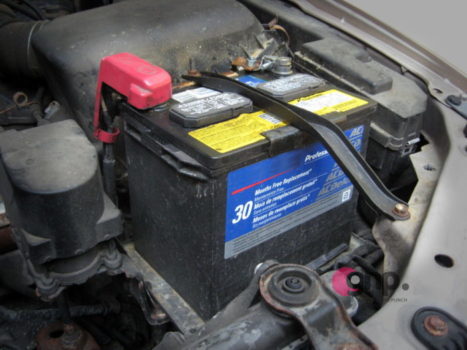No matter how well you maintain them, things like the weather and driving all place a strain on your car’s battery.
But, there are a few things you can do to extend the life of your battery.
Some batteries do allow for electrolytes to be topped up to keep the plates from drying out, etc, and if you’ve got this type of battery there’ll usually be a window on it so you can see the fluid inside it; you should routinely check the fluid levels on your battery.
Beyond fluids, everyone should look at the condition of the heat shield for their battery because overheating of your battery can lead to it bulging and failing prematurely.
While you’re at it, look at the battery and make sure it’s securely fastened in and that the leads are attached and looking healthy; you’re looking for corrosion (caused by current passing through two dissimilar metals) which can be cleaned off the battery posts and the clamps…but remember to fit a battery memory minder before removing the clamps.
When your battery drops below ‘functional’ you’ll see a battery indicator light on your dashboard. Most people, at this point, will assume the battery is dead.
A fully functional/charged battery should measure around 12.6 volts or more, and when the vehicle is running this should jump to more than 13.7 volts.
If the battery falls below 12.6 volts then it’s unlikely your vehicle’s engine won’t turn over.
You can test your battery’s output by using a multi-meter to test the voltage.

This issue can be corrected via the correct multi-stage battery charger; what this does is mix the electrolyte and battery acid, and restore the battery to good health – indeed you can recharge a battery from flat using a good battery charger.
What your alternator does is provide what’s called top-up charging only, but if the alternator isn’t functioning properly then this too can have an impact on your battery.
If the battery runs down too far, the alternator won’t be able to top it up and it’ll end up ‘surface charging’ the battery which will further damage the thing and lead to premature failure.
See, your battery is just there to start the car, once that’s been done, the alternator takes over (it’s a generator converting mechanical energy into electricity) and it runs your vehicles electrics and provides a top-up charge for the battery, but it can’t recharge the battery while you’re driving around.
Another killer of batteries is inactivity. Being parked up for a length of time can see the battery naturally discharge; there’s also a draw on the battery from key electrical systems in use even when the car is stationary.
One of the ways you can prevent your battery from discharging totally if you’re away from it for several weeks is to connect a battery charger; most battery chargers can work as a maintenance or trickle charger and keep the battery charged without causing damage to it.
It’s worth noting that, removing the battery from the vehicle won’t stop it from discharging but what it will do is likely cause damage to your vehicle.
Remember, there are sensitive electrical items in your vehicle that require constant feeding (electricity).
If you do remove the battery from your car, while replacing it, you’ll need to use a memory minder to ensure the electricals are kept fed until the new battery is installed.
Now, here’s the big DIY that I’ve never read in any online guide to battery maintenance but one which most good mechanics should know…A friend recently had their battery replaced by a Lube Mobile mechanic, and I don’t mind naming names in this instance. The guy swapped over the battery when a good charger would probably have fixed the issue.
Anyway, the battery was replaced, but the mobile mechanic advised that it was only a short-term fix and that the alternator was on the way out as it wasn’t ‘charging’ correctly.
The mechanic then quoted for a brand-new alternator.
At this stage, my friend called me and I said, pay for the battery and nothing else and, instead, told them to book an appointment with their regular mechanic.
This they did. There was nothing wrong with the alternator, rather the car’s on-board computer simply needed to be told a new battery had been installed.
Once this was done and everything checked, everything was working fine. And still is almost three months later.
So, while changing a car battery is a pretty simple thing, it does require some non-standard equipment.
If you think your battery is failing, then book your car in with your regular mechanic.


















